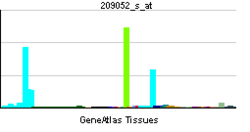WHSC1
Probable histone-lysine N-methyltransferase NSD2 is an enzyme that in humans is encoded by the WHSC1 gene.[1][2][3]
This gene encodes a protein that contains four domains present in other developmental proteins: a PWWP domain, an HMG box, a SET domain, and a PHD-type zinc finger. It is expressed ubiquitously in early development. Wolf-Hirschhorn syndrome (WHS) is a malformation syndrome associated with a hemizygous deletion of the distal short arm of chromosome 4. This gene maps to the 165 kb WHS critical region and has also been involved in the chromosomal translocation t(4;14)(p16.3;q32.3) in multiple myelomas. Alternative splicing of this gene results in multiple transcript variants encoding different isoforms. Some transcript variants are nonsense-mediated mRNA (NMD) decay candidates, hence not represented as reference sequences.[3]
References
- ↑ Stec I, Wright TJ, van Ommen GJ, de Boer PA, van Haeringen A, Moorman AF, Altherr MR, den Dunnen JT (Jan 1999). "WHSC1, a 90 kb SET domain-containing gene, expressed in early development and homologous to a Drosophila dysmorphy gene maps in the Wolf-Hirschhorn syndrome critical region and is fused to IgH in t(4;14) multiple myeloma". Hum Mol Genet 7 (7): 1071–82. doi:10.1093/hmg/7.7.1071. PMID 9618163.
- ↑ Chesi M, Nardini E, Lim RS, Smith KD, Kuehl WM, Bergsagel PL (Nov 1998). "The t(4;14) translocation in myeloma dysregulates both FGFR3 and a novel gene, MMSET, resulting in IgH/MMSET hybrid transcripts". Blood 92 (9): 3025–34. PMID 9787135.
- ↑ 3.0 3.1 "Entrez Gene: WHSC1 Wolf-Hirschhorn syndrome candidate 1".
Further reading
- Gutmajster E, Rokicka A (2003). "[Genetic determination of Wolf-Hirschhorn syndrome ]". Wiad. Lek. 55 (11-12): 706–10. PMID 12715353.
- Bergemann AD, Cole F, Hirschhorn K (2005). "The etiology of Wolf-Hirschhorn syndrome.". Trends Genet. 21 (3): 188–95. doi:10.1016/j.tig.2005.01.008. PMID 15734578.
- Wright TJ, Ricke DO, Denison K et al. (1997). "A transcript map of the newly defined 165 kb Wolf-Hirschhorn syndrome critical region.". Hum. Mol. Genet. 6 (2): 317–24. doi:10.1093/hmg/6.2.317. PMID 9063753.
- Chesi M, Nardini E, Brents LA et al. (1997). "Frequent translocation t(4;14)(p16.3;q32.3) in multiple myeloma is associated with increased expression and activating mutations of fibroblast growth factor receptor 3.". Nat. Genet. 16 (3): 260–4. doi:10.1038/ng0797-260. PMID 9207791.
- Richelda R, Ronchetti D, Baldini L et al. (1997). "A novel chromosomal translocation t(4; 14)(p16.3; q32) in multiple myeloma involves the fibroblast growth-factor receptor 3 gene.". Blood 90 (10): 4062–70. PMID 9354676.
- Kikuno R, Nagase T, Ishikawa K et al. (1999). "Prediction of the coding sequences of unidentified human genes. XIV. The complete sequences of 100 new cDNA clones from brain which code for large proteins in vitro.". DNA Res. 6 (3): 197–205. doi:10.1093/dnares/6.3.197. PMID 10470851.
- Malgeri U, Baldini L, Perfetti V et al. (2000). "Detection of t(4;14)(p16.3;q32) chromosomal translocation in multiple myeloma by reverse transcription-polymerase chain reaction analysis of IGH-MMSET fusion transcripts.". Cancer Res. 60 (15): 4058–61. PMID 10945609.
- Garlisi CG, Uss AS, Xiao H et al. (2001). "A unique mRNA initiated within a middle intron of WHSC1/MMSET encodes a DNA binding protein that suppresses human IL-5 transcription.". Am. J. Respir. Cell Mol. Biol. 24 (1): 90–98. doi:10.1165/ajrcmb.24.1.4224. PMID 11152655.
- Rauch A, Schellmoser S, Kraus C et al. (2001). "First known microdeletion within the Wolf-Hirschhorn syndrome critical region refines genotype-phenotype correlation.". Am. J. Med. Genet. 99 (4): 338–42. doi:10.1002/ajmg.1203. PMID 11252005.
- Perfetti V, Coluccia AM, Intini D et al. (2001). "Translocation T(4;14)(p16.3;q32) is a recurrent genetic lesion in primary amyloidosis.". Am. J. Pathol. 158 (5): 1599–603. doi:10.1016/S0002-9440(10)64115-6. PMC 1891955. PMID 11337357.
- Santra M, Zhan F, Tian E et al. (2003). "A subset of multiple myeloma harboring the t(4;14)(p16;q32) translocation lacks FGFR3 expression but maintains an IGH/MMSET fusion transcript.". Blood 101 (6): 2374–6. doi:10.1182/blood-2002-09-2801. PMID 12433679.
- Strausberg RL, Feingold EA, Grouse LH et al. (2003). "Generation and initial analysis of more than 15,000 full-length human and mouse cDNA sequences.". Proc. Natl. Acad. Sci. U.S.A. 99 (26): 16899–903. doi:10.1073/pnas.242603899. PMC 139241. PMID 12477932.
- Intini D, Fabris S, Storlazzi T et al. (2004). "Identification of a novel IGH-MMSET fusion transcript in a human myeloma cell line with the t(4;14)(p16.3;q32) chromosomal translocation.". Br. J. Haematol. 126 (3): 437–9. doi:10.1111/j.1365-2141.2004.05048.x. PMID 15257719.
- Gerhard DS, Wagner L, Feingold EA et al. (2004). "The status, quality, and expansion of the NIH full-length cDNA project: the Mammalian Gene Collection (MGC).". Genome Res. 14 (10B): 2121–7. doi:10.1101/gr.2596504. PMC 528928. PMID 15489334.
- Keats JJ, Maxwell CA, Taylor BJ et al. (2005). "Overexpression of transcripts originating from the MMSET locus characterizes all t(4;14)(p16;q32)-positive multiple myeloma patients.". Blood 105 (10): 4060–9. doi:10.1182/blood-2004-09-3704. PMC 1895072. PMID 15677557.
- Hudlebusch HR, Theilgaard-Mönch K, Lodahl M et al. (2005). "Identification of ID-1 as a potential target gene of MMSET in multiple myeloma.". Br. J. Haematol. 130 (5): 700–8. doi:10.1111/j.1365-2141.2005.05664.x. PMID 16115125.

